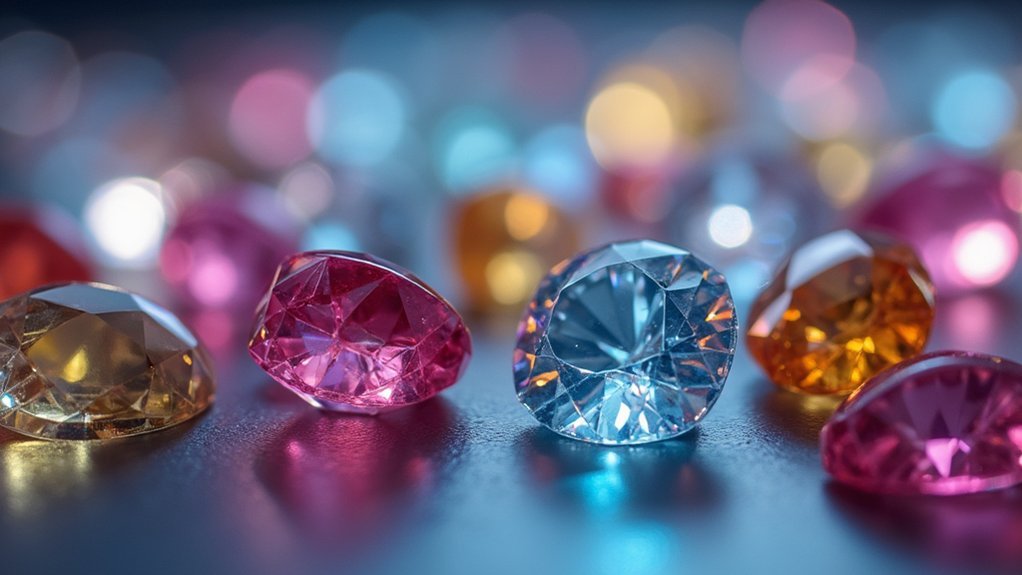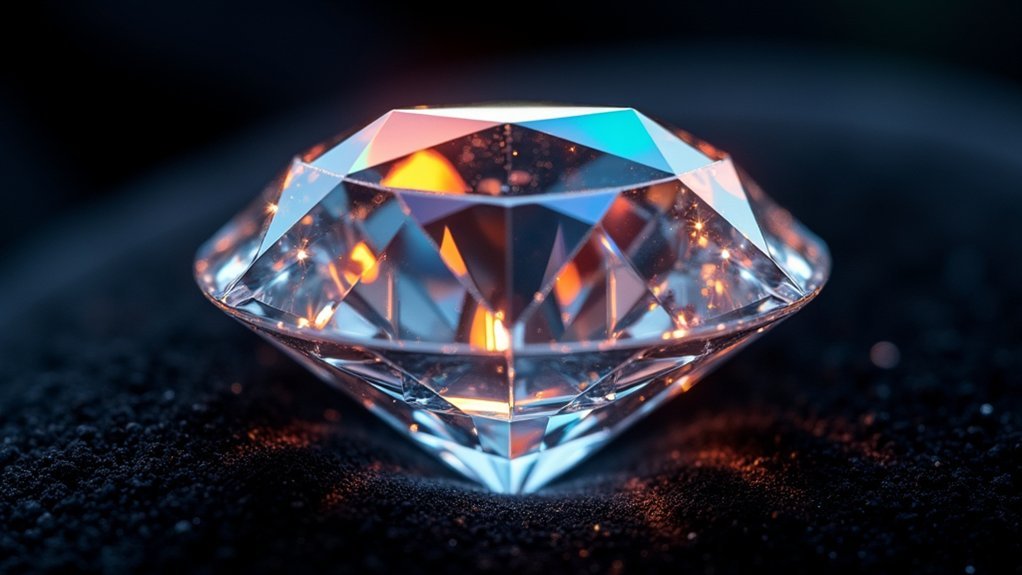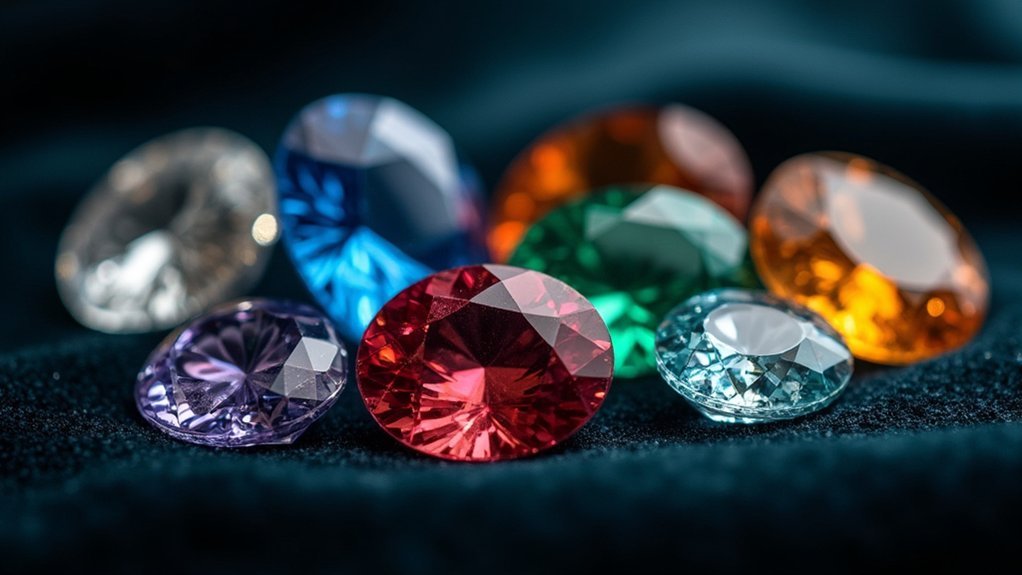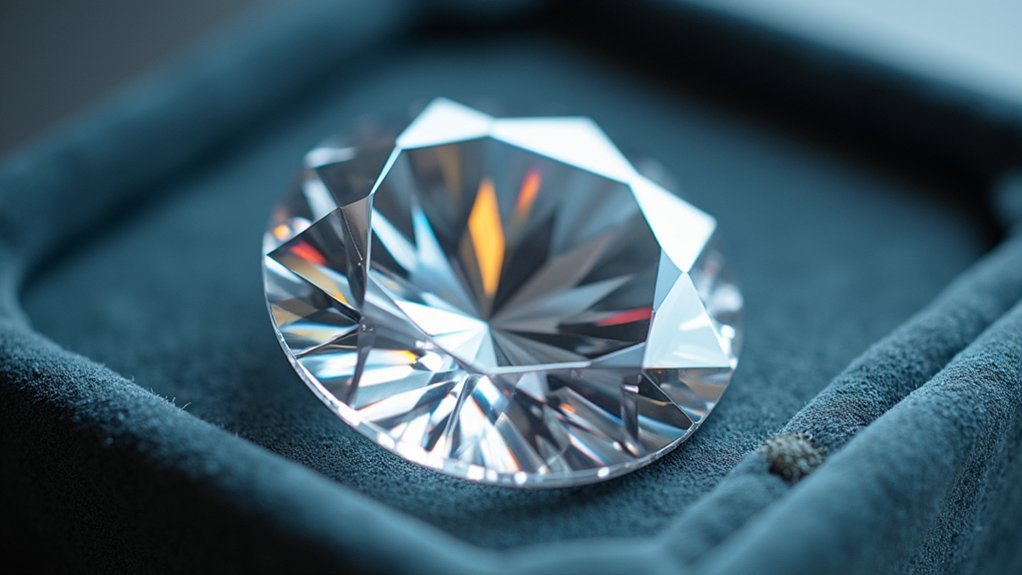When evaluating a gemstone’s cut quality, focus on symmetry, proportion, and light performance. You’ll want to examine how brilliance (white light reflection), fire (color dispersion), and scintillation (light patterns) interact within the stone. Look for precision in facet alignment, appropriate girdle thickness, and well-balanced proportions between 60-80% depth. Avoid stones with poor symmetry, windowing, or misaligned facets that diminish value. Expert assessment techniques vary by gemstone type, revealing the true artistry behind each precious creation.
The Art of Precision: Understanding Craftsmanship Markers

The hallmark of exceptional gemstone cutting lies in its precision—a delicate balance where craftsmen make calculated decisions that dramatically affect a stone’s value.
Precision defines the art of gem cutting—where every facet reflects a master’s decision that transforms raw potential into lasting value.
When you’re examining precious stones, look beyond minor deviations to assess how the cut quality enhances color and overall aesthetics.
You’ll notice that superior craftsmanship reveals itself in perfect symmetry and balanced proportions. Even with slight imperfections, a well-shaped gem typically maintains significant market value.
Pay special attention to girdle thickness—it shouldn’t be extremely thin (risking chips) or excessively thick (adding unnecessary weight).
The stone’s polish and facet alignment are equally critical indicators. A truly masterful cut displays mirror-like surfaces that maximize light performance.
Symmetry and Proportion: Foundations of Superior Cuts
While all aspects of gem cutting contribute to overall beauty, symmetry and proportion form the essential foundation upon which a stone’s brilliance rests.
You’ll notice that perfectly aligned facets create harmonious symmetry, maximizing light performance and enhancing visual appeal. Even minor deviations can diminish a gem’s perceived quality and value.
Well-executed proportions—the precise relationship between table size, crown height, and pavilion depth—ensure optimal light refraction and reflection.
These elements work together to generate the enchanting brilliance and fire that distinguish superior stones. When evaluating cut quality, experts meticulously assess these attributes, assigning grades that directly correlate with a gem’s aesthetic excellence.
The highest graded cuts demonstrate impeccable symmetry and ideal proportions, commanding premium prices for their exceptional ability to manipulate light into dazzling displays.
Light Performance: Brilliance, Fire, and Scintillation Factors

Light performance serves as the ultimate expression of a gem’s cut quality, manifesting through three essential characteristics you’ll immediately notice in superior stones.
Brilliance, the white light reflection within the gemstone, captivates viewers with its intensity when proportions are optimized.
The mesmerizing dance of white light within perfectly proportioned gemstones creates brilliance that captures attention instantly.
Fire displays the colorful spectrum created through light dispersion, becoming more pronounced in well-cut stones with precise symmetry.
As you move a gemstone, you’ll observe scintillation—the dynamic play of light and dark patterns—which depends on facet alignment and polish quality.
These optical qualities aren’t independent; they’re interconnected aspects of light performance that skilled cutters balance meticulously.
The higher the cut grade, the more impressive these visual effects become, making well-cut gemstones dramatically more appealing and valuable than their poorly-cut counterparts.
Common Cutting Flaws and Their Impact on Value
When examining a gemstone’s value, understanding prevalent cutting flaws can save you thousands in potential investment errors. Poor symmetry and uneven girdle thickness greatly affect how light interacts with your stone, reducing its brilliance and appeal.
| Cutting Flaw | Impact on Value |
|---|---|
| Off-center table | Creates windowing; light passes through without reflection |
| Incorrect proportions | Alters appearance; lowers cut grade considerably |
| Poor polish | Diminishes mirror-like quality; reduces overall brilliance |
| Misaligned facets | Disrupts light patterns; decreases scintillation |
While minor flaws might be offset by an attractive shape, considerable cut quality issues will overshadow even excellent color and clarity. You’ll notice these imperfections immediately in how the gemstone performs in different lighting conditions. Professional evaluations of cut quality consider these elements when determining a stone’s true market value.
Advanced Assessment Techniques for Different Gemstone Types

Because each gemstone variety possesses unique optical properties, you’ll need specialized evaluation techniques beyond basic cut grading.
When examining colored gemstones, pay particular attention to proportions and symmetry, which allow light to enter and return properly, maximizing brilliance.
Check the depth percentage—aim for 60-80% to avoid windowing issues that compromise overall appearance. Under magnification, inspect facet junctions; precise, mirror-like surfaces indicate superior craftsmanship.
For fancy shapes, the length-to-width ratio dramatically affects aesthetic appeal.
Remember that specific cutting styles are chosen to enhance particular quality factors in different gems. For example, emeralds benefit from step cuts that showcase color, while sapphires may require different approaches.
Frequently Asked Questions
How Do You Know if a Gem Is Well Cut?
You’ll recognize a well-cut gem by its balanced proportions, precise facet alignment, mirror-like polish, ideal depth percentage (60-80%), and brilliant light reflection. It’ll appear symmetrical with minimal visible imperfections.
How to Tell the Quality of Gemstones?
You’ll identify quality gemstones by examining their color (vibrancy and evenness), clarity (lack of inclusions), cut (brilliance and symmetry), carat weight, and transparency. Always check for treatments that might affect value.
What Is the Cut Grade of a Gemstone?
Cut grade measures how well a gemstone is faceted, affecting its brilliance and value. You’ll notice superior cuts reflect light beautifully. It’s rated from poor to excellent, with top grades commanding higher prices.
How Do You Check Gem Quality?
To check gem quality, you’ll need to examine clarity, color, carat weight, and cut. Look for inclusions, assess color consistency, weigh the stone, and evaluate how light interacts with it.
In Summary
You’ll find that mastering cut quality assessment transforms how you appreciate gemstones. When you’re examining a stone, don’t just look at its sparkle—evaluate its symmetry, proportions, and light performance. By recognizing cutting flaws and applying the right assessment techniques for each gem type, you’ll make more informed decisions. Remember, a well-cut stone of lower quality often outshines a poorly cut stone of higher quality.





Leave a Reply